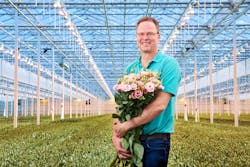Another large floriculture operation has implemented a mix of conventional high-pressure sodium (HPS) lighting with LED in the greenhouse, rather than going solely with one or the other. And, once again, LED is serving the role of heat moderator in the horticultural lighting system, preventing the growing environment from getting too hot.
The LEDs also provide more precise spectral tuning than the HPS lights.
This time, family-owned flower company Lugt Lisianthus deployed about 75% HPS and 25% LED over 5.8 hectares at a newly-built greenhouse that it opened last November in Monster, Holland to grow lisianthus — a colorful bouquet flower that’s also known as the Texas bluebell among other names, including its scientific appellation, Eustoma grandiflorum.
Lisianthus likes sun and heat. But there’s a fine line across which too much of either is detrimental. That’s why Lugt chose a mix of HPS, known for emitting heat, and LED luminaires, which run with a much cooler output owing to superior energy efficiency. Installer Stolze Installatie Techniek, based in Maasdijk, Holland, used HPS lights from Monster-based Hortilux, and used LED luminaires from Signify, which provided its Philips GreenPower LED brand.
Signify built the luminaires with an unchangeable spectra optimized for lisianthus. While Signify sometimes provides GreenPower systems that can use smart controls to change spectra on site (which could be handy if a grower changes crops, for instance), Lugt Lisianthus chose to use a fixed, lisianthus-oriented setting.
The HPS lights emit a more general grow light spectra.
According to Signify, the combination is providing a nurturing 364 µmol/s/m2, while preventing the heat buildup from hitting excessive levels. Without the inclusion of LED, light would have been capped at fewer micromoles.
The LEDs are useful throughout the year in this role. In the summertime, LEDs enable Lugt to tap the benefits of tuned, artificial lighting. Without LED, Lugt would curtail artificial lighting during summertime.
The company is pleased with the results.
“Where we used to be able to grow 5 flowers per branch, we are now at 15 flowers per branch,” said co-owner Marcel van der Lugt. “We have also been able to shorten the cultivation period to 8 weeks and have almost doubled the shelf life to 14 days.”
The companies did not reveal how much Lugt paid for the lighting system.
Lugt is poised to add LED to the HPS mix at an existing greenhouse, according to Signify. The Lugt site has a total of 10 hectares, including the new 5.8-hectare installation.
Its hybrid horticultural lighting approach echoes an HPS/LED scheme at tomato growers Bryte in Holland and Den Berk Délice in Belgium, both of which were concerned that the greenhouse would get too hot with HPS only.
In a slightly different example, Dutch rose grower Marjoland recently deployed a hybrid LED/HPS scheme in which it counted on HPS for heat and on LED for spectral tuning, light levels, and energy efficiency.
Conversely, Belgian tomato grower Tomato Masters took a different approach by deploying 100% LED lighting and then taking measures to assure its greenhouse stayed warm in the winter.
MARK HALPER is a contributing editor for LEDs Magazine, and an energy, technology, and business journalist ([email protected]).
For up-to-the-minute LED and SSL updates, why not follow us on Twitter? You’ll find curated content and commentary, as well as information on industry events, webcasts, and surveys on our LinkedIn Company Page and our Facebook page.

Mark Halper | Contributing Editor, LEDs Magazine, and Business/Energy/Technology Journalist
Mark Halper is a freelance business, technology, and science journalist who covers everything from media moguls to subatomic particles. Halper has written from locations around the world for TIME Magazine, Fortune, Forbes, the New York Times, the Financial Times, the Guardian, CBS, Wired, and many others. A US citizen living in Britain, he cut his journalism teeth cutting and pasting copy for an English-language daily newspaper in Mexico City. Halper has a BA in history from Cornell University.





